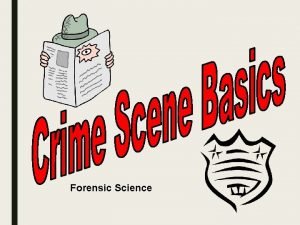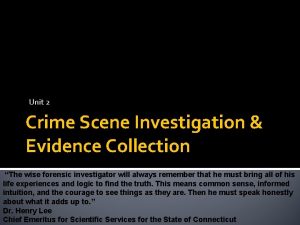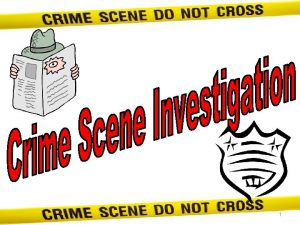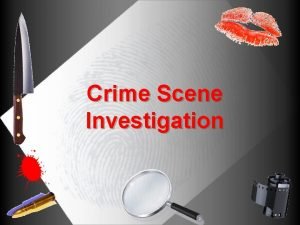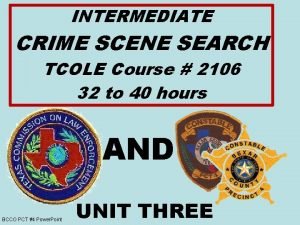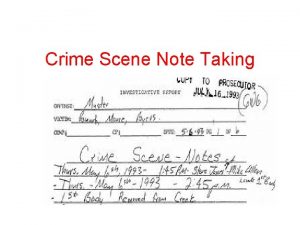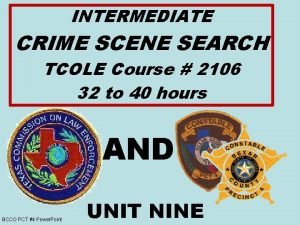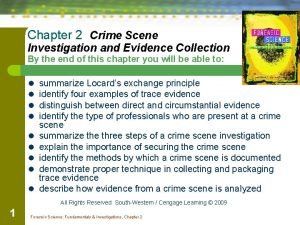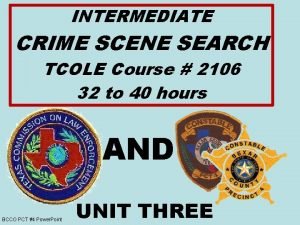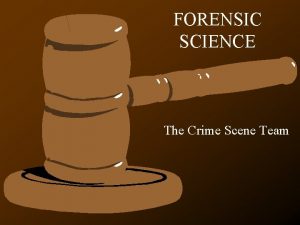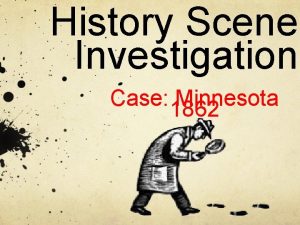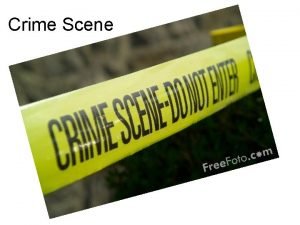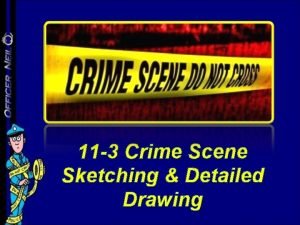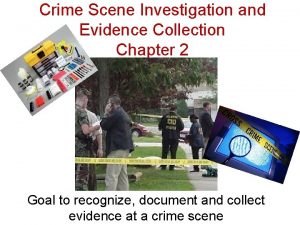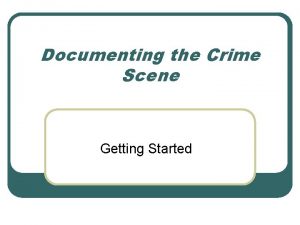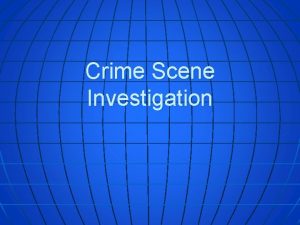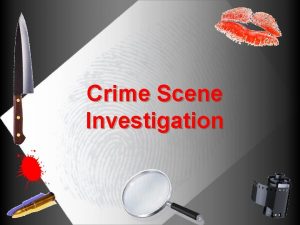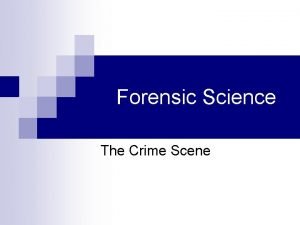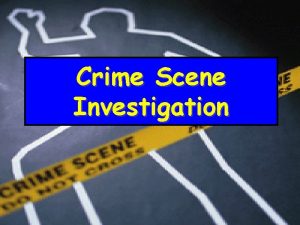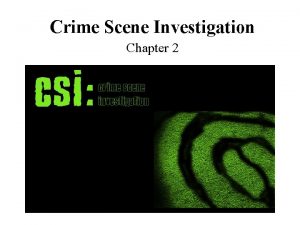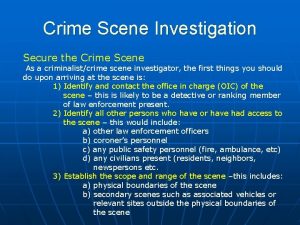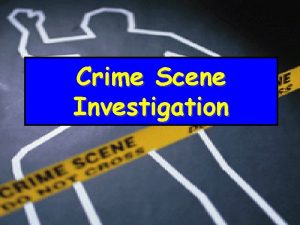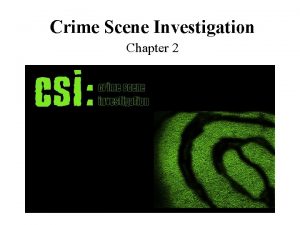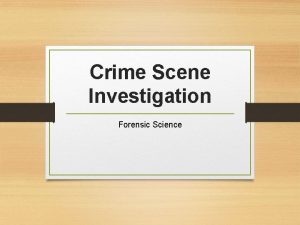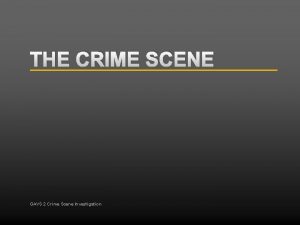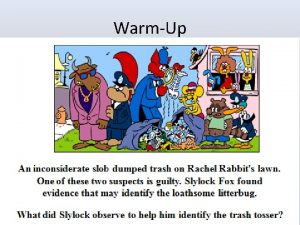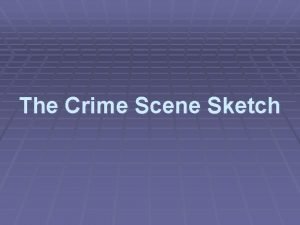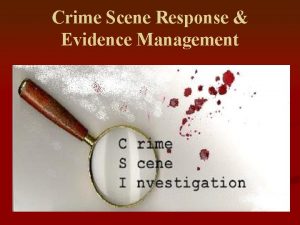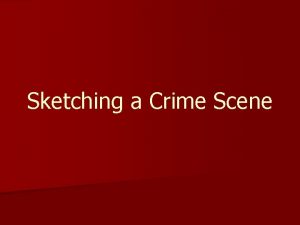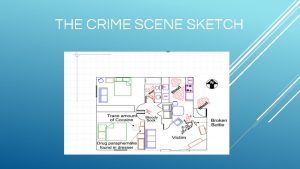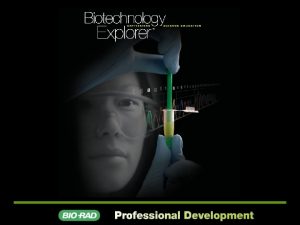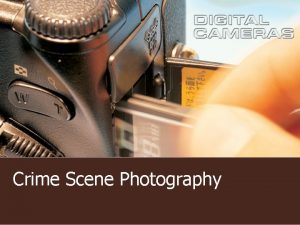CRIME SCENE INVESTIGATION Crime scene investigation It is





















- Slides: 21

CRIME SCENE INVESTIGATION

Crime scene investigation • It is the meeting point of science, logic and law. • The use of physical evidence at the scene of the crime and the use of deductive and inductive reasoning to gain knowledge of the events surrounding the crime.

Who's at the Scene? • Police officers are typically the first to arrive at a crime scene. They arrest the perpetrator if he's still there and call for an ambulance if necessary. They are responsible for securing the scene so no evidence is destroyed.

• The CSI unit documents the crime scene in detail and collects any physical evidence.

• The district attorney is often present to help determine if the investigators require any search warrants to proceed and obtain those warrants from a judge.

• The medical examiner (if a homicide) may or may not be present to determine a preliminarycause of death.

• Specialists (entomologists, forensic scientists, forensic psychologists) may be called in if the evidence requires expert analysis.

• Detectives interview witnesses and consult with the CSI unit. They investigate the crime by following leads provided by witnesses and physical evidence.

At the Crime Scene: Scene Recognition • When a CSI arrives at a crime scene, he doesn't just jump in and start recovering evidence. The goal of the scene recognition stage is to gain an understanding of what this particular investigation will entail and develop a systematic approach to finding and collecting evidence. At this point, the CSI is only using his eyes, ears, nose, some paper and a pen.


At the Crime Scene: Scene Documentation • The goal of crime-scene documentation is to create a visual record that will allow the forensics lab and the prosecuting attorney to easily recreate an accurate view of the scene.

Photographs • Overview shots are the widest possible views of the entire scene. • Mid-range photos – this shows the key pieces of evidence in context, so the photo includes not only the evidence but also its location in a room and its distance from other pieces of evidence.

Sketches • CSIs also create sketches to depict both the entire scene, which is easier to do in a sketch than in a photograph because a sketch can span several rooms, and particular aspects of the scene that will benefit from exact measurements.

Video • A video recording can offer a better feel for the layout of the crime scene -- how long it takes to get from one room to another and how many turns are involved, for instance. Also, once the investigation is further along, it may reveal something that was overlooked at the scene because the investigators didn't know to look for it.

At the Crime Scene: Finding the Evidence • The goal of the evidencecollection stage is to find, collect and preserve all physical evidence that might serve to recreate the crime and identify the perpetrator in a manner that will stand up in court.

Typical kinds of evidence • Trace evidence (gunshot residue, paint residue, broken glass, unknown chemicals, drugs) • Impressions (fingerprints, footwear, tool marks) • Body fluids (blood, semen, saliva, vomit) • Hair and fibers • Weapons and firearms evidence (knives, guns, bullet holes, cartridge casings) • Questioned documents (diaries, suicide note, phone books)

Examining the scene • The inward spiral search: The CSI starts at the perimeter of the scene and works toward the center.

• The outward spiral search: The CSI starts at the center of scene (or at the body) and works outward.

• The parallel search: All of the members of the CSI team form a line. They walk in a straight line, at the same speed, from one end of crime scene to the other.

• The grid search: A grid search is simply two parallel searches, offset by 90 degrees, performed one after the other

• The zone search: the CSI in charge divides the crime scene into sectors, and each team member takes one sector. Team members may then switch sectors and search again to ensure complete coverage.
 Bindle definition forensics
Bindle definition forensics Semen collection bags
Semen collection bags Crime scene investigation background
Crime scene investigation background What are the seven s's of crime scene investigation
What are the seven s's of crime scene investigation Tcole 2106
Tcole 2106 Crime scene vocabulary
Crime scene vocabulary Small amounts of trace evidence can be conveniently
Small amounts of trace evidence can be conveniently Crime scene investigation 2106 tcole course
Crime scene investigation 2106 tcole course Note taking crime scene investigation
Note taking crime scene investigation 2106 crime scene investigation
2106 crime scene investigation Locard exchange principle
Locard exchange principle Tcole 2106 course
Tcole 2106 course Grid linear spiral and quadrant are all
Grid linear spiral and quadrant are all Deductive reasoning crime scene investigation
Deductive reasoning crime scene investigation History scene investigation
History scene investigation Historical scene investigation
Historical scene investigation Boston massacre crime scene
Boston massacre crime scene Evidence crime scene
Evidence crime scene Crime scene drawing
Crime scene drawing While the csi team is searching the crime scene, _____.
While the csi team is searching the crime scene, _____. Graphsketch
Graphsketch Sketch of locality in crime scene
Sketch of locality in crime scene

